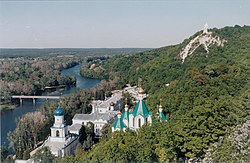
Back Donets Afrikaans ሰቨርስኪ ዶኔትስ ወንዝ Amharic Danaisincel ANG نهر سيفيرسكي دونتس Arabic نهر سيفيرسكى دونتس ARZ Ríu Donets AST سیورسکی دونتس چایی AZB Северскі Данец Byelorussian Северскі Данец BE-X-OLD Северски Донец Bulgarian
| Donets | |
|---|---|
 View of the Donets and Sviatohirsk Lavra, the Holy Mountains. | |
 Map of the Donets basin | |
 | |
| Location | |
| Country | Russia, Ukraine |
| Cities | Belgorod, Lysychansk, Sievierodonetsk |
| Physical characteristics | |
| Source | |
| • location | Prokhorovsky District, Belgorod Oblast, Russia |
| • coordinates | 50°57′52″N 36°54′9″E / 50.96444°N 36.90250°E |
| • elevation | 200 m (660 ft) |
| Mouth | Don |
• location | Rostov Oblast, Russia |
• coordinates | 47°36′1″N 40°53′48″E / 47.60028°N 40.89667°E |
• elevation | 5.5 m (18 ft) |
| Length | 1,053 km (654 mi) |
| Basin size | 98,900 km2 (38,200 sq mi) |
| Discharge | |
| • average | 159 m3/s (5,600 cu ft/s) |
| Basin features | |
| Progression | Don→ Sea of Azov |
The Seversky Donets (Russian: Се́верский Доне́ц) or Siverskyi Donets (Ukrainian: Сіверський Донець), usually simply called the Donets, is a river on the south of the East European Plain. It originates in the Central Russian Upland, north of Belgorod, flows south-east through Ukraine (Kharkiv, Donetsk and Luhansk Oblasts) and then again through Russia (Rostov Oblast) to join the river Don, about 100 km (62 mi) from the Sea of Azov. The Donets is the fourth-longest river in Ukraine, and the largest in eastern Ukraine, where it is an important source of fresh water. It gives its name to the Donets Basin, known commonly as the Donbas, an important coal-mining and industrial region in Ukraine.